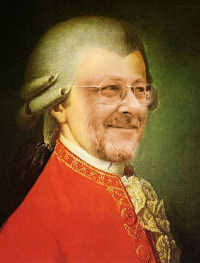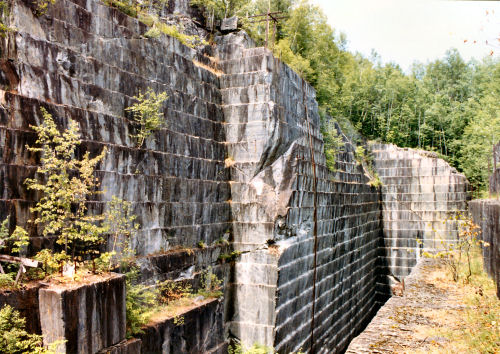A 365-Day Project
"We Are All Mozart"
A project to create
new works and change
the perception of the
music of our time.


 November 17, 2006
November 17, 2006 
When you're out of the academic loop, how do you preserve your historical contributions? I'll apologize right up front for the self-focus of this commentary, but there are times when I'm surprised (almost shocked, if I'm at all shockable) by the shameless rewriting of history in new nonpop. Certainly it's impossible to create historical authenticity in the arts, if only because there are so many artists and the documenters -- largely the academicians -- take no notice of trends outside the ivy walls. For that matter, the popular documenters are found inside another sort of wall, the city. And others inside the genres themselves.
What's really staggering, though, is how late attributions can be. Take this line: "an electronic chamber opera that breaks new ground in the field of concert-going by combining sounds and smells." That's from the Times (London) from an article entitled Scratch and sniff: the opera, describing a composition by Walter Prati, Lumen 3 being presented at the Huddersfield Contemporary Music Festival. Unless "opera" is the operant word, then this is simply wrong. Not only is Lumen 3 not the first concert-going event combining sounds and smells, it's off by at least ten years. Would I dare take credit for primacy in such a description? Not without research, but one would expect research from a journalist and even moreso of the composer or ensemble making the claim.
So here's the deal: An electronic chamber drama entitled Circular Screaming was premiered in concert on August 18, 1996 in Vermont. It used near-darkness, subtle lighting through a quarter-ton of ice, and an array of carefully infused smells from flowers through curries to sulphur, smells that were dispersed through large ducts and coordinated with the 90-minute score. Circular Screaming was composed, directed and performed by composers David Gunn and me, and out of it were later derived David's piano composition Fogwalls and my own electroacoustic Xirx.
There's historical discontinuity, but sometimes the events are parallel. In the early 1990s, Michel Chion's 1973 Requiem was played for me by composer Alcedo Coenen. Not knowing the Requiem's date, I was captivated by its sound and construction, and later surprised to realize that it was created simultaneously with my own i cried in the sun aïda. Yet Chion's work is groundbreaking, my own is ignored. Even the renewed interest in aïda and the presence of a democratic internet with a 'leveling effect' on historical events has not acknowledged the composition's groundbreaking characteristics. Could it be that aïda was composed in Trenton, New Jersey, and Chion's Requiem was composed in Paris? Artists and their historians like to claim that art rises above status, but the work of a rusting industrial city in New Jersey is one of many exceptions that never make it to the musicology texts.
Moving on. Recently considerable attention has come to an "air guitar" shirt. Let's examine this. Sensors embedded in the shirt algorithmically convert motion of the wearer into idiomatic riffs. What if sensors embedded in an outfit converted motion into avant-garde riffs? Would that be groundbreaking? Now admittedly an earlier outfit pre-dated wireless technology, but Network C/R was a composition and motion-suit design -- created in three versions on September 1-4, 1975. Again, however, it was composed in Trenton. Some years later, a wireless suit called the "BodySynth" was demonstrated by Chris Van Raalte at MedArt International, and at Logos, radar positioning was used. But the air guitar is presented as groundbreaking, in 2006.
There's more, since this is a for-the-record commentary. Use of sampling predates anything I've done. Stockhausen did it, Tenney did it. But (for the record) one of the earliest surround-sound sampling compositions was my own piece for two trombones and playback (called "tape" back then) entitled Construction "on nix rest... in china", finished in February 1972 -- and premiered in 2003 in Amsterdam. This piece was among my misunderstood wasteland of experimental compositions. "What are all these sounds doing in there that you did not create?" It was noise, nonsense. Until it was finally heard, that is. This launches another topic: What does it feel like to wait more than thirty years for a piece to be played? It's not Bach, but even so, his Brandenburg Concertos were an exception in a life when most of his repertoire was performed within days or weeks of its creation.
That wait was a strange experience, but only in retrospect. The truth is that almost none of my works were played during the first six years of my compositional life. Of the more than one hundred compositions written during those years, only a dozen small pieces were played. As a result, there was no expectation of performance -- and more than that, there was no regret. Perhaps the prolific nature of my writing is a result of not being held back by the mechanics of performances, the dealing with performers, the producers and ticket-takers, the grant writing and budgeting. The lack of waiting performers meant my imagination could roam well beyond the abilities of 1970 New Jersey and on to, in the case of Construction, 2003 Amsterdam, or for 1971's Exequy on the Death of Igor Stravinsky, twenty years into the future in 1991 Montpelier, Vermont. Music coming back to life gives some composers pause; they're not alone. One wants to be able to reach back in time and change the ineffective, deepen the shallow, extend the truncated. Instead, though, one can look at these as artifacts.
One more. The resurgence of chamber opera seems natural, and composers a generation younger than I have never known a time when composing them was an uncommon event. Not even the Huddersfield folks mentioned at the outset with their score-o-smells. But in 1977, there were the trailing remnants of Amahl and the new but large-scale minimalist operas of Philip Glass. Everyone else? Performance events, post-Fluxus avant-garde. Except... for... Plasm over ocean, finished on July 11, 1977. Lyrics by David Gunn, music by me.
Okay, so we've got the for-the-record stuff finished unless, of course, other innovative work is post-datedly found. The real question is -- here it comes -- what have you done for me lately?
Aye, there's the problem. Not in 1972 nor 1973 nor 1975 nor 1977 nor even 1996 was it clear that our work was groundbreaking. There is no feedback loop of creativity in the public sphere, and that in the cities is parochial and in the academy is a destructive spiral. In other words, we have to wait another decade to see if ECLM or density-based composition or even productivity-based composition will be meaningful. Cheap out, no?
No. Let's go back to the creation of those five pieces. For Construction, the idea of playing with other music in a radio-record collage just seemed interesting. As the piece developed, the various layers of sound became familiar and inevitable, the first principle of composition: that there be no other sound that belongs at that fractional sliver of time. The actual process of composition is long forgotten, but at no point during its creation did it speak aloud, "you are breaking new ground." The inevitable was being created.
The interplay of voices wasn't inevitable in aïda. It was just there. This was a dream piece, created in full form (as my self-repeated anecdote reports) as a dream and written down in the middle of the night. The manuscript exists in that tiny, light pencil script that my hand creates when I am nearly asleep, sick, or taking groggy-making medicine. It bears no corrections. Yet, though it didn't seem inevitable, it sounds inevitable. Groundbreaking? Not for a moment. Just visceral and deeply meaningful in a forgotten way. It touches ... something.
What about Network C/R? It was written during the years of my infatuation with a dancer, and in my mind her motion could translate into sound. The process of invention was driven by the result, not the process. How could I drape her body in a way that would force the image before my watery eyes to become manifest in sound? Several years earlier, my hand-built rose organ gave me the concept of light and motion from the outside; a sensor suit was its inverse, the electronic responding by their motion to the fixed light upon them. It was not imagination for the ages that created Network, but love and lust.
And so we arrive at Plasm over ocean, that moment that pivoted the avant-garde into the ritualistically tonal. In truth, I have no recollection of the idea's genesis. Opera sounded exotic. David Gunn, ever the wordsmith, would create the libretto. I would build instruments for it, and our ensemble that had performed for a half-dozen years would rehearse it as it was composed. The Dashuki Music Theatre had a flexible membership, some dedicated musicians, some amateurs of adventurous stripe. In a summer's frenzy, instruments were built, costumes and masks created, sound and lighting designed, words written and music composed. Plasm over ocean premiered on a concert that included the avant-garde of Phill Niblock and Joseph Celli. Plasm was the odd man out. My erstwhile composition instructor attended and dismissed it. Niblock and Celli ignored it. And yet it stood as an early and unique creation invented in the interstices where performance art, the avant-garde, and the future ritual/minimal compositional stream would be moving. Groundbreaking? Important? Who knows. We were making a show together.
Which cycles back to Circular Screaming and its ten-year foreshadowing of Lumen 3. What was the point behind it? It was experiment. The compositional life is boring outside the moment of creation, filled with day jobs and failed economics. The creation of something interesting, especially in a rural area with minds not urban and cynical, is always rewarding. It might fail. Perhaps twenty-five people attended that night as we set up two computers, mixers and amps and speakers, blocks of ice, lights and dimmers, fans and ducts. Envelopes of powders and bottles of oils sat ready. Composed and improvised sections were prepared. It was an event, a catharsis, and a pure experiment in our integrity and the trust of an audience. Perhaps it was even groundbreaking, but that had never been on our minds.
And so this is a commentary of record. Perhaps I am the Willy Loman of composition, packing my samples and eventually fading away. "Willy was a salesman. And for a salesman, there is no rock bottom to the life."
* * *
Today word came that my wife Stevie and I would be in residence at the Nodar Guest Studio in April 2007, to begin our study of birth song worldwide, including the creation of new electroacoustic work based on it.

Yesterday the commentary spoke about Vermont's verde antique marble. This is the top level of the depeleted quarry in Roxbury (a town in which I once lived). In the quarry, some 300 feet deep cut into the center of the hill and now half-filled with water, only small fragments of verde antique remain -- a lustrous serpentine marble surrounded by veins of asbestos. It was once shipped across the world, and you can still see it at the Chicago Stock Exchange. The quarry and all who worked there are now long gone.